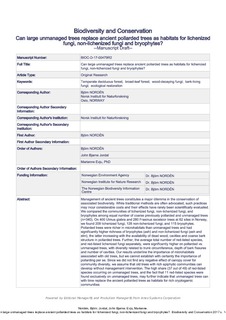| dc.description.abstract | Management of ancient trees constitutes a major dilemma in the conservation of
associated biodiversity. While traditional methods are often advocated, such practices may
incur considerable costs and their effects have rarely been scientifically evaluated. We
compared the communities of lichenized fungi, non-lichenized fungi, and bryophytes
among equal number of coarse previously pollarded and unmanaged trees (n = 340). On
400 Ulmus glabra and 280 Fraxinus excelsior trees at 62 sites in Norway, we found 209
lichenized fungi, 128 non-lichenized fungi, and 115 bryophytes. Pollarded trees were
richer in microhabitats than unmanaged trees and had significantly higher richness of
bryophytes (ash) and non-lichenized fungi (ash and elm), the latter increasing with the
availability of dead wood, cavities and coarse bark structure in pollarded trees. Further, the
average total number of red-listed species, and red-listed lichenized fungi separately, were
significantly higher on pollarded versus unmanaged trees, with diversity related to trunk
circumference, depth of bark fissures and number of cavities. Our results underline the
importance of microhabitats associated with old trees, but we cannot establish with certainty
the importance of pollarding per se. Since we did not find any negative effect of
canopy cover for community diversity, we assume that old trees with rich epiphytic
communities can develop without management intervention. The high share (37 out of 49)
of red-listed species occurring on unmanaged trees, and the fact that 11 red-listed species
were found exclusively on unmanaged trees, may further indicate that unmanaged trees can
with time replace the ancient pollarded trees as habitats for rich cryptogamic communities. | nb_NO |
